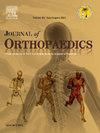Outcomes after revision total shoulder arthroplasty with pectoralis major transfer
IF 1.5
Q3 ORTHOPEDICS
引用次数: 0
Abstract
Background
Irreparable tears of the subscapularis muscle pose a difficult problem to patients and the treating physician. Pectoralis major transfers (PMTs) are often used in patients with irreparable tears of the subscapularis muscle with good outcomes. Similarly, PMT used in conjunction with shoulder arthroplasty has been proposed for patients with deficient subscapularis muscles and end stage glenohumeral arthritis. The data for PMT done in the setting of shoulder arthroplasty is sparse in the literature. This study aims to be among the first to report on long-term outcomes for arthroplasty done concomitantly with PMT.
Methods
This is a retrospective case series of patients who underwent PMT for subscapularis tendon deficiency in conjunction with revision total shoulder arthroplasty (TSA) by a single surgeon between 2000 and 2017. Patients indicated for shoulder arthroplasty who had an irreparable subscapularis tear were considered for pectoralis major transfer. Exclusion criteria were lack of postoperative radiographic imaging and follow-up time of less than 12 months. Primary endpoints included shoulder range of motion and patient reported outcomes.
Results
5 patients were included. The mean time to the last follow-up visit for revision TSA was 10.0 years (range 3.3–15.1). Only one patient had increased passive external rotation at final follow-up. Implant survivorship was 100 %; there were no further revisions or surgical interventions. Forward elevation increased from 69 ± 57° to 100 ± 69°, external rotation was 42 ± 19° to 42 ± 26°, and internal rotation improved from L4 to L2. ASES scores improved from 25 ± 11 to 39 ± 26, SST scores increased from 3 ± 3 to 6 ± 3, and VAS scores decreased 8 ± 1 to 6 ± 2.
Conclusion
PMT with revision shoulder arthroplasty provides satisfactory range of motion and shoulder function in patients with irreparable subscapularis tears. This study evaluated mid-to long-term data and demonstrated favorable outcomes in revision TSA with PMT patients. TSA concomitant with PMT for a deficient subscapularis was particularly effective in improving stability, internal rotation, and reducing passive external rotation.
Level of evidence
IV, retrospective case series.
求助全文
约1分钟内获得全文
求助全文
来源期刊

Journal of orthopaedics
ORTHOPEDICS-
CiteScore
3.50
自引率
6.70%
发文量
202
审稿时长
56 days
期刊介绍:
Journal of Orthopaedics aims to be a leading journal in orthopaedics and contribute towards the improvement of quality of orthopedic health care. The journal publishes original research work and review articles related to different aspects of orthopaedics including Arthroplasty, Arthroscopy, Sports Medicine, Trauma, Spine and Spinal deformities, Pediatric orthopaedics, limb reconstruction procedures, hand surgery, and orthopaedic oncology. It also publishes articles on continuing education, health-related information, case reports and letters to the editor. It is requested to note that the journal has an international readership and all submissions should be aimed at specifying something about the setting in which the work was conducted. Authors must also provide any specific reasons for the research and also provide an elaborate description of the results.
 求助内容:
求助内容: 应助结果提醒方式:
应助结果提醒方式:


